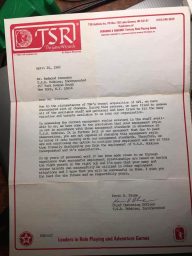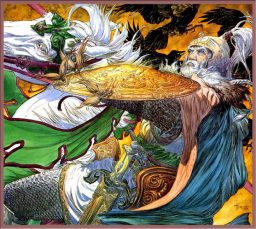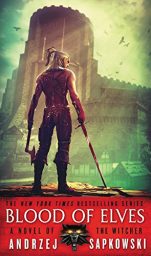Sensor Sweep: Lin Carter Children’s Fantasy, SPI, Kaluta, and Blood of Elves
Monday , 11, December 2017 Sensor Sweep 10 CommentsFiction (Tolkien and Fantasy): “Fantasiae was, according to its initial subtitle, the “monthly newsletter of the Fantasy Association,” based out of Los Angeles. The first issue was dated April 1973, and the final issue was no. 103 (volume 9 no. 10) from October 1981. The editor for the entire run was Ian M. Slater, who also contributed many articles and book reviews.
In the fourth issue, July 1973, Cory Panshin had a letter which noted:
“From what I’ve observed, the recent spate of children’s quality paperbacks hasn’t been very heavy on fantasy. I wonder if the Fantasy Association includes anyone with publishing connections to do a reprint program of children’s fantasy similar to what Lin Carter has done for Adult Fantasy with Ballantine?”
Gaming (Black Gate): “Around the end of 1981, brothers Kevin and Brian Blume wrested control of TSR away from founder Gary Gygax. The company  would change dramatically under their leadership, until Gygax returned from his west coast exile in 1984 and (briefly) reclaimed his company. One ‘Blume Incident’ from 1982 is a pretty good example of the way they did things.
would change dramatically under their leadership, until Gygax returned from his west coast exile in 1984 and (briefly) reclaimed his company. One ‘Blume Incident’ from 1982 is a pretty good example of the way they did things.
In 1958, Avalon Hill was formed, creating the modern wargaming industry, out of which role playing games grew. In 1969, James Dunnigan created Simulations Publications, Inc. — to be known as SPI — with Redmond Simenson as co-founder. He started the company to save an existing wargaming fanzine, Chris Wagner’s Strategy & Tactics, which was in a precarious financial state. Simenson was the graphic designer for the magazine and a huge part of its success. For the princely sum of $1 (yes, you read that right), SPI took on Strategy and Tactics and made it the industry’s leading newsletter, starting with the September, 1969 issue.”
Gaming (Dice & Discourse): “I was watching a video recently that was listing several of the “iconic” D&D monsters like the Beholder and Gelatinous Cube. What was interesting about this video was the narrator mentioning running away from or avoiding these monsters. This got me thinking about some if the philosophy of “old school” gaming, modern game design, what folks want out of RPGs and many other things.
First, I’d like to say that I in no way claim to be an “old school” gamer. I didn’t start table top gaming till the 90’s. I think my first exposure to D&D would have been the Saturday morning cartoon, and the AD&D first edition DM guide that one of my older siblings had (but only played once that I recall). I use to thumb through that book looking at all the pictures and imagining games of adventure, but never really got a chance to play till years later.”
Authors (Pulprev): “In the 1930s, the glory days of the pulp age, Robert E Howard cast a formidable shadow. The creator of Conan and Solomon Kane, a legendarily prolific writer with hundreds of stories and dozens of poems to his name, he molded the genres of weird fiction and sword and sorcery, leaving his mark forever. In his mythical Appendix N, Gary Gygax cited Howard’s Conan series as one of his many inspirations in creating Dungeons & Dungeons. Having heard much of Howard’s prowess, yet having never read any of his stories (the closest being the Conan animated series), I grabbed tomes of his stories and devoured everything I could find. What I found was breathtakingly magnificent.”
legendarily prolific writer with hundreds of stories and dozens of poems to his name, he molded the genres of weird fiction and sword and sorcery, leaving his mark forever. In his mythical Appendix N, Gary Gygax cited Howard’s Conan series as one of his many inspirations in creating Dungeons & Dungeons. Having heard much of Howard’s prowess, yet having never read any of his stories (the closest being the Conan animated series), I grabbed tomes of his stories and devoured everything I could find. What I found was breathtakingly magnificent.”
Art (Woelf Dietrich): “This week I have some old school fantasy and comic book art for you. I’ll be honest, I did not recognise his name, only the art, and I was happy to discover that I have a few of the Conan comics that he illustrated the covers for. I’m talking about Michael Kaluta.
Michael Kaluta is an American comics artist and writer best known for his acclaimed 1970s adaptation of the pulp magazine hero The Shadow with writer Dennis O’Neil. Michael stepped into the comic book business in 1969 with Carson of Venus, which appeared in DC’s Korak, Son of Tarzan. This was followed by his now exalted run on The Shadow in 1973, also published by DC.”
RPG (RPG.net): “I am writing this review from the perspective of someone with probably much less general RPG experience than most who write these reviews. In addition, I had minimal exposure to the works of Robert E. Howard (and Lovecraft). After reading the foreward and preface of this book, I have now been delving deep into the original works of Howard, and I must say, I never knew what I was missing! Howard is a masterful storyteller and his worlds are weird and amazing. Astonishing Swordsmen & Sorcerers of Hyperborea takes all that, mixes it with equal parts of old school and modern RPG mechanics, and then gives birth to a really kick ass gaming tome. At a minimum, if you never play this game verbatim, it is certainly worth reading for inspiration.”
Fiction (Mighty Thor Jr.): “I want to start off by saying I am NOT a gamer and know nothing of the video games. So if you want to talk to me about the games, sorry! Nothing against gamers, its just not my thing. I know the games were based on these books, and are very popular, but that is as far as my  knowledge goes. I have seen many people say how great these books are, and that they are very Sword and Sorcery, Conan Esq pulpy fantasy, which is totally me! So yes I had to check them out!
knowledge goes. I have seen many people say how great these books are, and that they are very Sword and Sorcery, Conan Esq pulpy fantasy, which is totally me! So yes I had to check them out!
The first book (The Last Wish) I read was fantastic, but I was a little disappointed in the second book (Sword of Destiny). Those were both collections of short stories about the adventures of Geralt of Rivia. They captured the Sword and Sorcery, Conan pulpy feel I love so much, some great modern S&S. I was hoping this first novel would again deliver like the first book. Unfortunately it did not. Still a very good book and I recommend it to other readers, but it was missing something. I can’t place what was missing, but it just felt different. Maybe this character lends himself better to short story format. I plan on continuing this series as I do enjoy it. I hope the next book can recapture that certain something that had me loving The Last Wish collection.”
It occurred to me the other day that despite following both Castalia House and The Pulp Revolution movement; I don’t actually know how to define what a Pulp Story is. I initially thought it was Red Fiction but then learnt that Blue Fiction and Pink Fiction were published in them as well. I then thought it was from a time-period known as the Golden Age or Pulp Age; but then I saw several stories from the Silver Age or Campellian Age, referred to as Pulp Stories. So, my question of the week is: How do you the members of this movement define what is or is not a Pulp Story? Cause I’m completely lost.
P.S. I have recently read/listened to a few Stories by Robert E Howard and have become a huge fan. I’m more interested in his less famous works instead of his Fantasy and Historical works which I knew of. Thus, does anyone know where I can find his Comedy Stories? The Robert Howard Foundation hasn’t published a Collection of them.
-
From what I’ve seen, pulp fiction is fiction that would have been printed in a pulp magazine. That is fiction focussed on entertaining a paying audience, rather than making a point or cementing the author’s claim that he is worthy of literary immortality.
As such, the work could be Red, Blue, Pink, Plaid, or Purple Polka-dotted–as long as there was a reasonably large paying audience for it. Heck, they’d’ve published long-winded social commentary in rhythmless, rhyme-free “verse,” if people had wanted to pay them for it.
-
Some of the Sailor Steve Costigan stories are comedic. And still pretty funny, too! I can’t remener which ones specifically but all of the ones I read were pretty entertaining; misadventures in various ports, boxing, hijinks, etc.
Very different from Conan. But just as entertaining.
-
I was thinking more along the lines of: After the Game, Eighttoes Makes A Play, Sleeping Beauty. Generally all of the stories published in Yellow Jacket.
-
As Terry said, a true definition of pulp fiction would be a story published on pulp paper. “Pulp” has come be used for lurid and sensational fiction, often post-pulp with digest magazines such as MAN-HUNT or Gold Medal paperbacks. A pulp story from the 1910s is going to be something different from the 1940s. I think pulp is often meant a lean, hardboiled type of story efficient in execution from the middle 1920s to the 1950s.
-
But in each case, the emphasis would be on what *sells.* Or, if you prefer, a focus on the customer, rather than the gatekeeper or the academic with upper-class pretensions.
-
That certainly would be a new definition. Gatekeepers and academics have traditionally sneered at best at genre oriented fiction. I think genre fiction could be used as a term in regards to gatekeepers and academics. Not all academics are anti-popular fiction. There are graduate students doing papers on things that formerly would be laughed at in English departments. The PCA has a conference every year though some of those papers are written in a strange language of academic wankery.
-
-
A few years ago Bison Books did a few Howard collections, including a comedy western collection called The Riot at Bucksnort. Seems like they’re still fairly cheap, so maybe check out that one?
Thanks for sharing my post, and for all of the great links to check out! Love this article every week!
Great post from Cheah.